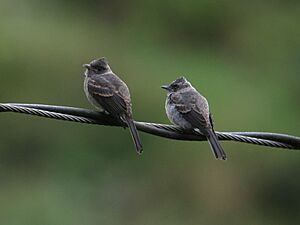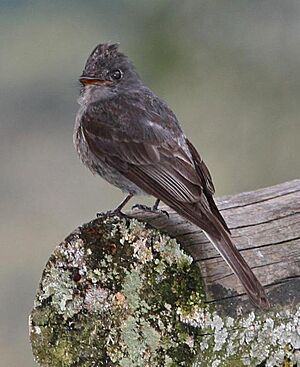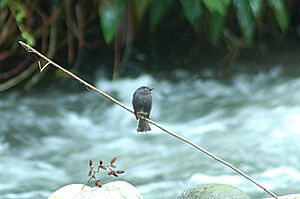Smoke-colored pewee facts for kids
Quick facts for kids Smoke-colored pewee |
|
|---|---|
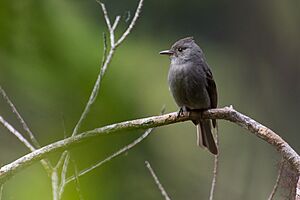 |
|
| Conservation status | |
| Scientific classification | |
| Genus: |
Contopus
|
| Species: |
fumigatus
|
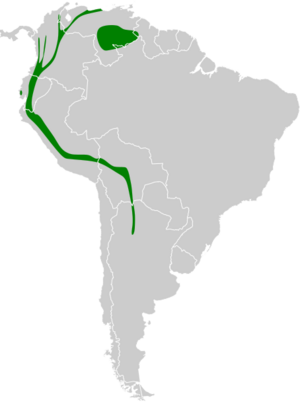 |
|
The smoke-colored pewee (Contopus fumigatus) is a type of bird that belongs to the tyrant flycatcher family. These birds are mostly a uniform dusky-grey color.
You can find smoke-colored pewees in countries like Argentina, Bolivia, Brazil, Colombia, Ecuador, Guyana, Peru, and Venezuela. They live in warm, wet forests, including mountain forests, and even in areas where forests have been cut down.
Contents
About the Smoke-Colored Pewee
The smoke-colored pewee is part of the Tyrannidae family, also known as tyrant flycatchers. This is the largest bird family on Earth, with over 400 different kinds of birds. These birds come in many shapes and colors. You can find them in every country in the Americas.
French naturalists Alcide d'Orbigny and Frédéric de Lafresnaye first officially described this bird in 1837. They found a specimen in the Bolivian Yungas. The name Contopus comes from ancient Greek words meaning "pole" and "foot." The name fumigatus comes from a Latin word meaning "smoke."
There are six known types, or subspecies, of the smoke-colored pewee:
- C. f. ardosiacus (Lafresnaye, 1844) - Found in Colombia, western Venezuela, eastern Ecuador, and northeastern Peru.
- C. f. cineraceus (Lafresnaye, 1848) - Lives in subtropical northern Venezuela.
- C. f. duidae (Chapman, 1929) - Found in the Tepuis mountains of southern Venezuela and nearby Guyana.
- C. f. zarumae (Chapman, 1924) - Lives in southwestern Colombia, western Ecuador, and northwestern Peru.
- C. f. fumigatus - This is the original type (d'Orbigny & Lafresnaye, 1837). It is found in southeastern Peru and western Bolivia.
- C. f. brachyrhynchus (Cabanis, 1883) - Also found in southeastern Peru and western Bolivia.
What Smoke-Colored Pewees Look Like
The smoke-colored pewee is a grey bird. It has a small crest of feathers on its head. Their beaks are orange with a black upper part, called a culmen.
Adult birds are about 16-17 cm (6-7 inches) long. They weigh about 18-20 grams (0.6-0.7 ounces). Both male and female birds look the same. This means they show no sexual dimorphism. Their feet have three toes pointing forward and one pointing backward. This is common for perching birds.
Feather Colors
Adult smoke-colored pewees have mostly grey feathers, also called plumage. Their upper body and wing tips might have a slight olive or light brown tint. The top of their head is dark grey and has a small crest. The edges of some wing feathers might be light brown. They can have two faint, narrow bars on their wings, but these are hard to see.
Their throat, chest, and belly are a slightly lighter grey. The feathers under their tail are yellowish-white. Both male and female birds look alike. Birds found further north in their habitat tend to be darker and more grey.
Young smoke-colored pewees are usually lighter and browner than adult birds. They have a fringe of buff-colored feathers on the back of their neck, called the nape. You can see two or three wingbars on young birds. Both the wingbars and their belly have a slightly yellowish-brown color.
Where They Live
The smoke-colored pewee lives only in certain countries. These include Argentina, Bolivia, Brazil, Colombia, Ecuador, Guyana, Peru, and Venezuela. Their natural habitats are warm, dry forests. They also live in moist mountain forests and even in areas where forests have been heavily damaged.
These birds are usually found at heights of 1,000 to 2,500 meters (about 3,300 to 8,200 feet). In the Andes mountains, they can be found as high as 3,000 meters (about 9,800 feet). In southwestern Ecuador, they can live as low as sea level. They prefer mountainous areas and foothills, but they avoid flat lowlands.
Smoke-colored pewees usually stay in one place. They do not migrate to different areas.
How They Behave
Smoke-colored pewees often perch on small branches in the middle parts of trees. This is different from the similar Blackish pewee, which is a bit smaller and perches closer to the ground.
Bird Calls
The smoke-colored pewee makes many different sounds. A common call is a loud "pip pip pip." At dawn, you might hear a "where-di-WIT… whew." A clear, repeated "peeew" whistle is also common. Sometimes, though rarely, they make other sounds. These can range from a rough, repeated "zur" to a whistled "whueer" or short "pjeek pjeek" notes.
Reproduction and Life Cycle
Smoke-colored pewees have altricial chicks. This means their babies are born helpless and need a lot of care from their parents. They build cup-shaped nests from moss and lichen. They place these nests on high, horizontal branches.
Their eggs are white with brown and lavender spots. One study found that eggs hatch after 16 days. The young birds leave the nest 21 days after hatching. Both the male and female parent help feed the chick. However, only one bird builds the nest.
In a study of nine nests, all were active during the drier months, from September to December. The nests were, on average, 8.8 meters (about 29 feet) high. Parents covered the eggs for about 67% of daylight hours. Nestlings received about 3 to 10 feedings per hour. A clutch (group of eggs) usually has 2 to 4 eggs.
What They Eat
The smoke-colored pewee mainly eats insects. They catch these insects by "sallying." Sallying is a hunting method often used by flycatchers. The bird flies out from a perch to catch an insect in the air. Then, it returns to the same perch to eat its meal. Birds often go back to the same perch after each time they catch food.
Conservation Status
The smoke-colored pewee is listed as a species of least concern. This means it is not currently at risk of disappearing. You can find this bird in almost every protected area in the Andes mountains. Its habitat is large and spread out across South America. The species can also handle some changes to its habitat. The smoke-colored pewee is generally considered to be fairly common or common.



